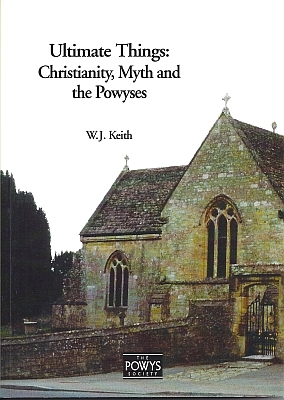Ultimate Things

Christianity, Myth and the Powyses
by W. J. Keith
If we consider the religious variety embraced by the offspring
of C.F. Powys and Mary Cowper Johnson, the full range of modern
western spiritual experience is represented. It extends from
full acceptance of Roman Catholicism (Littleton Alfred Powys,
JCP's son, who died a priest) to total rejection of Christian
claims (Llewelyn). In between, there are numerous gradations: a
considered preparedness to conform outwardly to tradition
(Littleton, Bertie, Will, and Lucy), a reformulated faith in the
Christian vision (Gerard Casey), as well as a stubborn,
resistant independence detectible in various ways in Gertrude,
Marian, and Katie - and, of course, the special cases of
Theodore's one-of-a-kind enigmatic private world-view, and JCP's
imaginative acceptance of all possibilities in a world
recognized as fascinating, mysterious, and ultimately
inscrutable. If in their basic solidarity they seem 'one
monstrous Powys', as individuals they were indeed 'many'.
Contents
Chapter 1: Background Information
Christianity and Myth — Theologians and Philosophers versus Writers and Artists
Chapter 2: Life at Montacute
The Role of the Father — The Shadow of the Vicarage — Sibling Variations
Chapter 3: Two Meanings of Myth
Llewelyn and ‘Luluization’ — Theodore and the Making of a Recluse — JCP and ‘Life-illusion’
Chapter 4: Llewelyn
Autobiography and the Shocks of Circumstance — Llewelyn as a Professional Writer — The Religion of an Atheist — Llewelyn: The Pros and the Cons — The Llewelyn Stone
Chapter 5: Theodore
Was Theodore a Christian? — Theodore’s Earliest Non-Fiction Writings — Interpreting Soliloquies of a Hermit — Theodore’s Thought in Fiction
Chapter 6: John Cowper
From Faith to Scepticism — Encountering William James — JCP’s ‘Saint Paul’ — The Soul, Other Dimensions, and Mystery — The Culmination in Porius
Chapter 7: The Next Generation: Mary and Gerard Casey
The Biographical Background — Mary’s The Kingfisher’s Wing and A Net in Water — Gerard’s Night Horizons — The Powys Influence
Chapter 8: The Powyses in the Modern World
‘Many Gods’ and ‘Sacred Places’ — One Powys or Many Powyses? — The Importance of the Powyses — Conclusion
Appendix: Textual Problems in Soliloquies of a Hermit
From Chapter 1 : Background Information
Christianity and Myth
The Reverend C.F. Powys (1843-1923)
was successively a curate at Bradford Abbas in Dorset (1867-72),
vicar of Shirley in Derbyshire (1872-9), a curate at Dorchester
in Dorset (1879-85), and vicar of Montacute in Somerset
(1885-1918). Between 1872 and 1890, he and his wife produced
eleven children, of which, remarkably for that period, ten lived
to maturity; moreover, four of them survived into or beyond
their ninetieth year. It was an exceptionally gifted family. The
three best known – John Cowper (1872-1963), Theodore
(1875-1953), and Llewelyn (1884-1939) – had substantial literary
careers, while four others each published at least one book.
Most of them, indeed, distinguished themselves in some sort of
artistic or intellectual endeavour. Littleton became an
influential headmaster, Gertrude an artist of considerable
ability studying and exhibiting in London and Paris, A.R. (Bertie)
a well-known architect, while Marian was recognized as a leading
authority on the creating and conservation of lace. Philippa
(Katie to family and friends), though hardly a successful
writer, published a slim volume of poetry and one novel in her
lifetime, but more fiction, poems and considerable extracts from
her diaries are now available. Interestingly, almost all of them
moved away from the Anglican Church in which they had been born
and brought up; at the same time, they remained acutely
responsive to religious issues and explored alternative
religious – or, at least, spiritual – beliefs.
In view of the
religious preoccupations that dominate the writings of John
Cowper, Theodore and Llewelyn, it seems essential that we
establish, as precisely as we can, not only the positions that
individual members of the family embraced, but also, as far as
possible, what they believed (and did not believe) at various
stages of their careers. By the same token, we need to determine
the extent to which they discussed religious matters with each
other, and in some cases notably influenced each other. However,
the Powyses themselves rarely made attempts to arrive at any
systematic conclusions.


